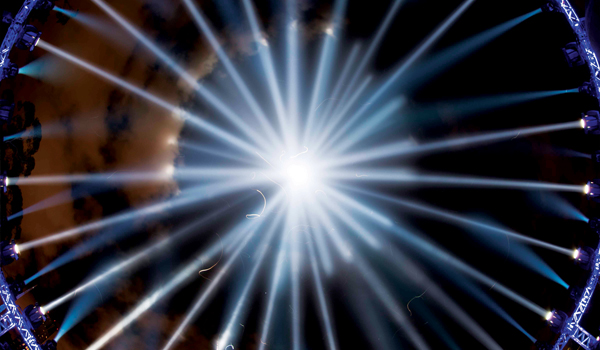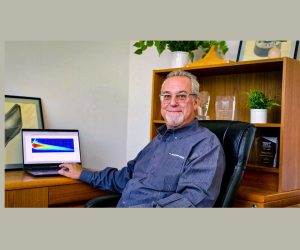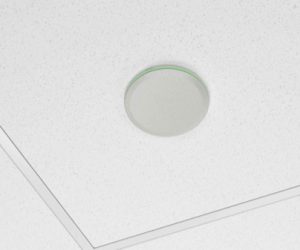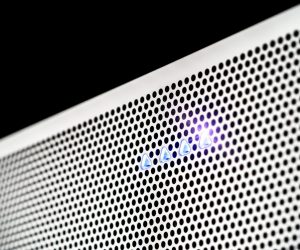
Beam Me Up
A lighting installation makes its mark in the White Night skies over Melbourne.
Text and Images:/ Paul Collison
It isn’t often that one walks away from a project with complete satisfaction. I can probably count on one hand the number of times that has happened in my career. Usually the circumstances around the project can lead to the satisfaction. Or it can be a particularly difficult set of challenges that you may have to overcome, or just a great group of people coming together to produce something special, or simply something that you thought of, that actually works. The recent Crepuscular Beam installation at the second White Night Festival in Melbourne, may have been a combination of all of those things.
White Night Melbourne is only in its second year in Australia, with attendances almost doubling since the inaugural event. At various points across the year, White Night festivals take place in over 20 countries around the world. The concept is for a short, 12-hour festival, incorporating a wide variety of live performance, artistic installations, architectural installations and more. White Night Festival Creative Director, Andrew Walsh, commissioned over 150 works for this year’s event. To say the overall event is a success would be to sell it short. As a lover of expressive art, I had a fantastic night exploring the various installations and venues. To have a hand in delivering the festival was an added bonus.
Crepuscular Beam was an installation that grew in scope from its inception. Originally I thought it to be a sculpture of light, a structure to form the backdrop of the festival and make a statement as a beacon to the greater CBD and Melbourne suburbia. It was Andrew Walsh who came up with the idea for some audio support. He suggested a soundscape to add some depth to the installation, particularly for those who made the arduous journey through the city to the Alexandra Gardens. Enter Russell Goldsmith, Melbourne-based sound designer and composer. Russell developed a soundscape built from sounds recorded by the NASA Voyager missions in the 1970s. Russell spent many hours combining sounds from the NASA archives to compile a 14 minute and 40 second piece. The seamless loop was designed to run exactly 50 times over the festival’s 12-hour duration.
NOT JUST A PRETTY BEAM
From my perspective, the installation needed to be more than just a bunch of searchlights pointing into the sky. Early ideas had them on the ground, all bunched up. We then had ideas to spread them around the gardens. However, the final, and ultimately-realised, concept, was for a 20m diameter, facetted-circle of 400mm box truss, raised 3m above the ground on truss legs. A group of 26 Panther 7kW xenon searchlights from Chameleon Touring Systems formed the basis of the design. Spread at approximately 2.5m intervals around the circle, they were interspersed with Vari-Lite VL3500 (1650W) wash lights. In order to make a localised visual statement, the truss structure was toned with 32 Pro Shop LED pars, and 32 Pro Shop LED truss toners. While it all sounds relatively simple, the build of the installation was not.
Rohan Thornton, technical manager of the White Night festival and lighting industry guru, worked hard with Resolution X to formulate a plan to build and raise the four-tonne structure into position. A single lifting point with slings to spread the load to eight points on the circle, was used to raise the structure up to 3m in order to get the leg supports in. This process was deemed safer, and easier than individually lifting each fixture in to place. Of course, it doesn’t take a genius to know that manhandling 150kg searchlights is easier at ground level than it is at 3m in the air while balancing on a ladder. Audio also used the truss structure to hang their Meyer UPQ-1P cabinets (eight facing inwards and four facing out) as well as the four inward-facing Meyer HP-700 subs that were all fed from the QLAB replay system. The same replay system also fed SMPTE timecode to the grandMA2 Light lighting controller. This meant the entire installation could run seemingly-unattended all evening.
Crepuscular adjective of, or pertaining to twilight. Hence figurative dim, indistinct, imperfectly enlightened. [Shorter Oxford dictionary]

FEW BITS SHORT OF A SMOOTH MOVE
The Panther 7k searchlights have an 8-bit (256 position) pan and tilt mechanism rather than the more accepted 16-bit (65,536 position) types found on almost every other moving light. This doesn’t pose much of a problem, unless you either need to hit an exact position, or do slow, live moves.
My intention was not to move these lights at all, regardless of the steppy movement. The VL3500 fixtures were intended to add a little bit of movement and greater colour control than the searchlights are capable of. However, as always, it was the sound track that called for a cue. There was an intense build calling for an erratic two-minute state of awkwardness. Over this period, the searchlights started an offset slow tilt move, that was steppy and jerky, but that suited the build in the soundscape. Had we been using other lights this look may not even have been possible. The move took the previous light canopy that sat above the inner part of the circle, and spread it out, opening up the sky to the spectators on the ground. A massive thud at the culmination of this passage snapped all the searchlights to zero, and changed the truss to a deep red for a brief moment. The searchlights then slowly returned to their intended look. It was a fitting bookend that usually ended with applause! The audience then moved on, making way for the next group to come and sit in the environment.
Blessed with a high particle count in the atmosphere, and low cloud for the greater part of the night, the visual strength of the 7k xenon beams were amazingly vivid. Reports of people seeing the installation from almost 25km away were most impressive, particularly considering the low point that we were projecting from. Close up, the reviews were wide and varied. Some people thought it was like aliens had landed, others just asked ‘why?’. Most, however, just appreciated something that simply looked wonderful, despite its restraint, and simplicity.
It takes a lot of skilled and dedicated people to put on an event like White Night, let alone a complicated installation like Crepuscular Beam. There are too many to thank individually, however without those wonderful people, events like White Night would never happen, and I’d never be able to shine lights at aliens.














RESPONSES